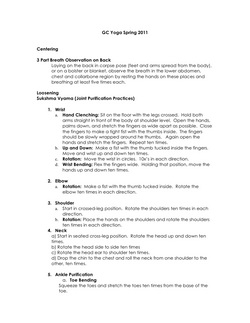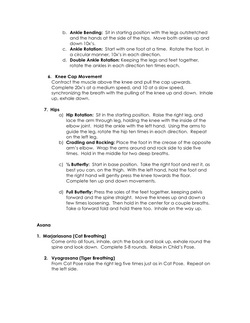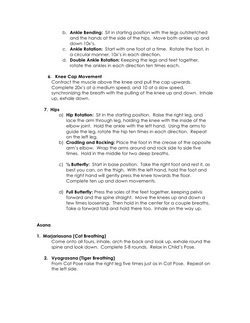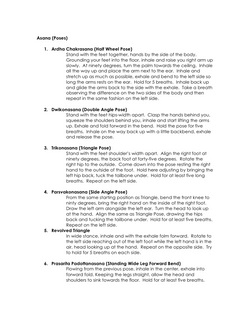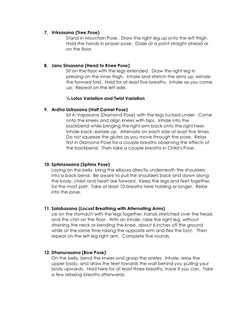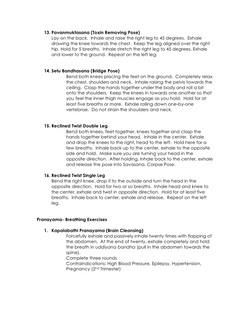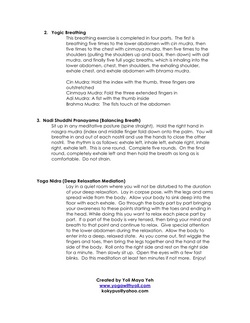Yoga with Yoli 2 credit Independent Study.
Daily routine practiced
Notes/Reflections
February 9th, 2011
7:30-9:20am
Yoli, told us about her history with yoga (circus yoga, baby yoga, yoga for disabled, yoga therapy, prenatal yoga…)
Started in Shivasana and went on to do small sitting and laying down stretches
Did (asana) breathing working
Did knee crumping (good to lubricate knees)
Sun salutation (stretch behind and then down over legs, flat back, right leg back and on the ground, downward dog, opposite leg forward etc.)
February 10th & 11th
7-9am
Feeling sore in my armpits, the crook in my hips, neck, and shoulders.
Went through same routine but on the 11th seemed to take a shorter amount of time.
Doing breath isolation with hand postures that activate certain neuron places; starts with stomach, then chest, then shoulders.
breath by pushing the stomach in on exhale.
On the 10th Yoli discussed that someone who just observed things and copied the positions physically invented yoga.
Building up sun salutation (11th we did 4 and the aim is 6)< I think
February 12th
5,000 years old (found physical or written or iconographical yoga poses)
but older then that
Yoga Rahasya (UNION NECTAR) 20-30,000 years old
Central deity concept dated 5,000 in tribal’s from Africa in South India < Aryans invaded next and took over, created Swarsati river (Pakistan) < found original form of Shiva
Jainism, Buddhism, etc. part of yoga history
Vedas were an oral tradition from the valleys to 3,000-15,000 BC
15,000-0 Women worship ended < Brahminical phase
Is yoga religious?
Buddha 500 BC (called Buddha a Hindu but Hinduism was caste system, he was shuktria) completes all that Gurus give, then go through the extremes and then realized that there needed to be a balance.
Buddha’s life/path to enlightenment was built on a very strong foundation
Guru’s moved to the west in India and ‘’went through the washing machine’’ and then came back
800 (yoga came to Tibet)
[Hatha Yoga Paradipika text (Goroknath) preparatory practices teachings to Natha Yogi Aghora]
Purpose is to tame animal nature (anger & sex)
Created for men because neural system is different for men and women especially when it comes to sex
4 Schools of Yoga
Karma- Action (volunteering, service of others, cleanse physically)
Jyana- Wisdom (text, philosophy debate)
Bhakti- Devotion (developed chants to certain deity, mantra, puja)
Raja- ‘Kings’ (8 limbed system)
Ashtanga System of Patanjali (don’t know where he is from for sure or exact date)
Patanjali got booted out
Different organization of system then Goroknaf
8 LIMBED SYSTEM (in this order)
1.Yama (ethics, things to cultivate)
2.Niyama (things to avoid)
3. Asana (poses)
4. Pranayama (breathing/life force energy, prana bioelectric field)
5. Pratyahara (turning the sense organs inward, result of practice)
6. Dharama (focus)
7. Dhyama (one point of focus)
8. Samadhi (states of bliss focus)
Goal of yoga - union with divine (religious)
Yuj (to yoke and harness animal, uniting personal humanness with universal divineness)
Personal Nirvana
Being in service to others
Goal oriented
Hatha (sun-moon) is the classical yoga of balancing sun and moon
Hinduism is not Indian
***LONG FIELD TRIP TO KERALA***
homework: practice the routine on my own
-did it almost every day and felt like I gained strength and comfort in poses.
Past couple of days was spent skipping the first part of warming up in the routine and staying longer in poses and moving to deepen the practice.
-Added more twisting postures
-Stayed longer and did more rounds in sun salutation
-Got adjustments in poses by the hands of teacher
-Added Shoulderstand pose major benefits: “strengthens and balances the function of the thyroid, which supervises the other glands, regulates metabolism and heat production…”
-added pauses in between in and out breathing to hold the breath when we do breathing exercises.
*My body has changed some, lost some weight in my love handles and my core is becoming more toned.
*sun salute is easier
*downward dog is improving
*found out I was doing tabletop wrong
*more flexibility to get to lotus but left side is not touching the ground and still tight
*my pushups are better
*sleeping better
Questions that I have been thinking about:
-Why is yoga so accessible to me? Who is it not available to?
-Who has practiced yoga historically, which group? How was yoga been practiced, through physical labor or only in the spiritual context?
-Can you ever do too much yoga? How much yoga is right for me?
March 5th
*did Netti for the first time, didn’t burn too much and my forehead and whole head felt closer and more open.
Started doing other cleanses for the rest of the classes
Chanting
Recipe for Kichiri
1 cup basmati rice
1/2 cup masoor daal (red lentils)
2 1/2 cups water
1/2 cup chopped onions
1/4 tsp tumeric
1 cinnamon stick or 2 tsp ground cinnamom
3 cardamom pods or 1/4 tsp ground cardamom
2 Tbsp olive oil
1 tsp ground ginger
1 clove garlic, minced
1. Wash and set aside lentils. Make sure you search for small rocks as they can get mixed in and look like lentils.
2. In a large pot heat olive oil.
3. Add onions and saute.
4. Add spices and garlic.
5. Add rice, lentils and water.
6. Bring to a boil, turn heat to low and cover for 10-15 minutes.
Makes 4 1-cup servings.
Number of Servings: 4
March 11th
-6 surface areas of the body
-we receive information from our nerves
-subtle nervous system
-7 major glands of body (neuro plexis)
-Prana is the life force energy
-aura is the magnetic field produced
-white is the reflection of all light (is white a color?)
-black is the absorption
*Ask about what energy comes when having an “enlightening” conversation.
-Reiki is 25% of 100% healing
-1997 to 2022 is the time of a crash called the Age of Aquarius
-age 13-18 you need to practice restrainment, be careful of greed, sex, and anger as they are lose downward energies
-women are more evolved then men because she contains both hormonal makeup of both sexes.
-platonic love
-the way to strengthen the nerves is through the muscles
-tantric and indigenous philosophies
7:30-9:20am
Yoli, told us about her history with yoga (circus yoga, baby yoga, yoga for disabled, yoga therapy, prenatal yoga…)
Started in Shivasana and went on to do small sitting and laying down stretches
Did (asana) breathing working
Did knee crumping (good to lubricate knees)
Sun salutation (stretch behind and then down over legs, flat back, right leg back and on the ground, downward dog, opposite leg forward etc.)
February 10th & 11th
7-9am
Feeling sore in my armpits, the crook in my hips, neck, and shoulders.
Went through same routine but on the 11th seemed to take a shorter amount of time.
Doing breath isolation with hand postures that activate certain neuron places; starts with stomach, then chest, then shoulders.
breath by pushing the stomach in on exhale.
On the 10th Yoli discussed that someone who just observed things and copied the positions physically invented yoga.
Building up sun salutation (11th we did 4 and the aim is 6)< I think
February 12th
5,000 years old (found physical or written or iconographical yoga poses)
but older then that
Yoga Rahasya (UNION NECTAR) 20-30,000 years old
Central deity concept dated 5,000 in tribal’s from Africa in South India < Aryans invaded next and took over, created Swarsati river (Pakistan) < found original form of Shiva
Jainism, Buddhism, etc. part of yoga history
Vedas were an oral tradition from the valleys to 3,000-15,000 BC
15,000-0 Women worship ended < Brahminical phase
Is yoga religious?
Buddha 500 BC (called Buddha a Hindu but Hinduism was caste system, he was shuktria) completes all that Gurus give, then go through the extremes and then realized that there needed to be a balance.
Buddha’s life/path to enlightenment was built on a very strong foundation
Guru’s moved to the west in India and ‘’went through the washing machine’’ and then came back
800 (yoga came to Tibet)
[Hatha Yoga Paradipika text (Goroknath) preparatory practices teachings to Natha Yogi Aghora]
Purpose is to tame animal nature (anger & sex)
Created for men because neural system is different for men and women especially when it comes to sex
4 Schools of Yoga
Karma- Action (volunteering, service of others, cleanse physically)
Jyana- Wisdom (text, philosophy debate)
Bhakti- Devotion (developed chants to certain deity, mantra, puja)
Raja- ‘Kings’ (8 limbed system)
Ashtanga System of Patanjali (don’t know where he is from for sure or exact date)
Patanjali got booted out
Different organization of system then Goroknaf
8 LIMBED SYSTEM (in this order)
1.Yama (ethics, things to cultivate)
2.Niyama (things to avoid)
3. Asana (poses)
4. Pranayama (breathing/life force energy, prana bioelectric field)
5. Pratyahara (turning the sense organs inward, result of practice)
6. Dharama (focus)
7. Dhyama (one point of focus)
8. Samadhi (states of bliss focus)
Goal of yoga - union with divine (religious)
Yuj (to yoke and harness animal, uniting personal humanness with universal divineness)
Personal Nirvana
Being in service to others
Goal oriented
Hatha (sun-moon) is the classical yoga of balancing sun and moon
Hinduism is not Indian
***LONG FIELD TRIP TO KERALA***
homework: practice the routine on my own
-did it almost every day and felt like I gained strength and comfort in poses.
Past couple of days was spent skipping the first part of warming up in the routine and staying longer in poses and moving to deepen the practice.
-Added more twisting postures
-Stayed longer and did more rounds in sun salutation
-Got adjustments in poses by the hands of teacher
-Added Shoulderstand pose major benefits: “strengthens and balances the function of the thyroid, which supervises the other glands, regulates metabolism and heat production…”
-added pauses in between in and out breathing to hold the breath when we do breathing exercises.
*My body has changed some, lost some weight in my love handles and my core is becoming more toned.
*sun salute is easier
*downward dog is improving
*found out I was doing tabletop wrong
*more flexibility to get to lotus but left side is not touching the ground and still tight
*my pushups are better
*sleeping better
Questions that I have been thinking about:
-Why is yoga so accessible to me? Who is it not available to?
-Who has practiced yoga historically, which group? How was yoga been practiced, through physical labor or only in the spiritual context?
-Can you ever do too much yoga? How much yoga is right for me?
March 5th
*did Netti for the first time, didn’t burn too much and my forehead and whole head felt closer and more open.
Started doing other cleanses for the rest of the classes
Chanting
Recipe for Kichiri
1 cup basmati rice
1/2 cup masoor daal (red lentils)
2 1/2 cups water
1/2 cup chopped onions
1/4 tsp tumeric
1 cinnamon stick or 2 tsp ground cinnamom
3 cardamom pods or 1/4 tsp ground cardamom
2 Tbsp olive oil
1 tsp ground ginger
1 clove garlic, minced
1. Wash and set aside lentils. Make sure you search for small rocks as they can get mixed in and look like lentils.
2. In a large pot heat olive oil.
3. Add onions and saute.
4. Add spices and garlic.
5. Add rice, lentils and water.
6. Bring to a boil, turn heat to low and cover for 10-15 minutes.
Makes 4 1-cup servings.
Number of Servings: 4
March 11th
-6 surface areas of the body
-we receive information from our nerves
-subtle nervous system
-7 major glands of body (neuro plexis)
-Prana is the life force energy
-aura is the magnetic field produced
-white is the reflection of all light (is white a color?)
-black is the absorption
*Ask about what energy comes when having an “enlightening” conversation.
-Reiki is 25% of 100% healing
-1997 to 2022 is the time of a crash called the Age of Aquarius
-age 13-18 you need to practice restrainment, be careful of greed, sex, and anger as they are lose downward energies
-women are more evolved then men because she contains both hormonal makeup of both sexes.
-platonic love
-the way to strengthen the nerves is through the muscles
-tantric and indigenous philosophies
